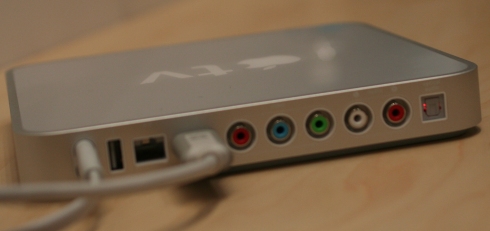Apple TV might obsolete the x86 appliance market

This may surprise you, but I'm going to order an AppleTV as soon as I can. Some of you might be wondering "who are you and what have you done with George" but no, I didn't get kidnapped at last week's MacWorld and I am the real George Ou. I don't own an iPod and I don't use iTunes, but the AppleTV interests me greatly and here's why. I'm going to make a bold prediction that AppleTV might just bring an end to the mini-ITX or mini PC market or at the very least cause a massive disruption if this article from Apple Insider is correct.
Mini PCs are notoriously slow and expensive compared to a cheap desktop size PC because they lack economy of scale. Anyone looking to build a small, silent, fast, yet energy efficient x86 appliance as some sort of firewall, or server is going to be spending more than $600. It might be possible to get something for $360 (money wire and shipping fees add up) if you're willing to order a sample direct from Taiwan and wait 6 weeks for manufacturing, assembly, and shipping. For all that trouble you get a small x86 appliance that might run at 533 to 800 MHz Via processor and a 20 GB 2.5" hard drive.

The Apple TV - at least according to Apple Insider - is built on an Intel Pentium M 1 GHz with 2 MBs of L2 cache, 256 MBs of onboard DDR2 400 MHz memory, and a 40 GB internal Hard Drive for a total price of $299! Note that a Pentium M 1 GHz processor is roughly equivalent to a 1.5 GHz Pentium 4 processor so it's plenty fast as a dedicated server appliance. The Pentium M 1 GHz CPU is also a very energy efficient part with a maximum TDP of 5 watts. This specification at this price just made every mini-ITX or mini PC obsolete because you can't come close to that specification without spending double that amount of money. That makes the AppleTV the ideal miniature appliance platform for running any x86 based application such as:
- Linux-based IPCop plus CopFilter gateway anti-virus firewall *
- Asterisk PBX telephony appliance **
- Linux server
- Microsoft SBS Small Business Server
- Microsoft Home Server
- Small branch office domain controller
- Microsoft ISA firewall appliance *
- A small/silent desktop PC (Windows XP, Linux, maybe even a hacked version Mac OS X for x86 computers) which is perfect for a car computer. Silent car computers easily cost more than $600 and this might be the perfect solution for an in-car entertainment system.
- Convert AppleTV to a full Media Center with a USB 2.0 tuner and MythTV to play any kind of audio and video files and not just iTunes
* Assuming it's possible to use VLAN tagging or add a second Ethernet port
** Assuming the USB port is USB 2.0, we can add a Xorcom Astribank analog telephony FXS/FXO phone port channel bank.
The possibilities for this are endless. The only challenge is installing a second Ethernet port if you're going to use this as some sort of router or firewall appliance. We might be able to get away with one Ethernet port if we can get 802.1q VLAN tagging working and we have a switch that supports VLANs. Since there is an 802.11n mini-PCI Express card in the system, we will be able to strip that out and put in an Ethernet Card in its place. The challenge will be getting the CAT-5 cable to an RJ45 socket which may not be mountable since you can see that there isn't much room on the back of the AppleTV. We might be able to cut out a hole on the side of the unit or rip out the optical jack used for digital audio and make that hole slightly larger for the second Ethernet port. The final option is to completely dump the AppleTV chassis and use the internal parts which would still be worth while because of the relatively low price. [UPDATE - The best suggestion came from reader Mark which is to use a USB to Ethernet adapter for the second network port. These are relatively inexpensive at around $15]
At this point it's mostly just speculation because we're not 100% sure if all of the leaked information on AppleTV specs are correct so hold off on your orders (unless you're actually buying it for its intended purpose). We'll be taking one apart at TechRepublic and we'll verify if it's possible to modify the AppleTV or not. The unit starts shipping next month so we'll have to wait and see how things go.
[poll id=11]